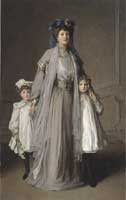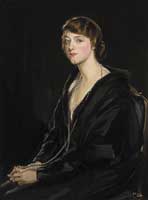Sampling of works by Lavery
The
Glasgow Exhibition, 1888
1888
Tangier,
The White City
1893
Mrs
Guthrie
1898

Mrs. Robert Finnie McEwen of Marchmont and Bardrochat,
with her Daughters, Katharine and Elizabeth
1907
Mrs.
Lavery Sketching
1910
Oil
on canvas, 203 x 99 cm
Hugh
Lane Municipal Gallery of Modern Art, Dublin
Jpg:
Irish
Impressionists
Sir
John Lavery RA
Edinburgh,
from Mons Meg
1917
Oil
on canvas
Provenance:
The Fine Art Society, London
61
x 76 cm - 24 x 30 inches approx.
Signed.
Signed and dated and titled verso.
£120000
Jpg:
www.archeus.co.uk
The
Bridge At Grez
Oil
on canvas
11.02
x 25.98 inches / 28 x 66 cm
Private
collection
arc
Portrait
of The Artist's Wife, Hazel
Jpg:
Irish
Impressionists
'Lady
Lavery'. 1928.
Sir
John Lavery, 1846 - 1941.
Framed
area: 20 X 24 inches (58 X 68 cm)
Picture
area: 13 x 15 1/2 inches (33 X 40 cm)
Reproduced
with the kind permission of The Central Bank Of Ireland
Jpg:
thepresidentsaward
"Cathleen
Ni Houlihan"
(Lady
Lavery)
The
Marchioness of Londonderry and Lady Mairi Stewart
1923
Jpg:
Irish
Impressionists
The
Jockeys' Dressing Room at Ascot
1923
A
Portrait of Joe Childs, the Rothschild's Jockey
1923
The
Lakes of Killarney
1913
Jpg:
Irish
Impressionists
Japanese
Switzerland
1913
Jpg:
Irish
Impressionists
Ambulance
Train
1918
Jpg:
Irish
Impressionists
A
Convoy, North Sea
1918
Jpg:
spartacus.schoolnet
Portrait
of George V
1929
Jpg:
Irish
Impressionists
King
George V, Accompanied by Queen Mary, at the Opening of the Modern
Foreign
and Sargent Galleries at the Tate Gallery, 26 June 1926
1926
The
Opening of the Modern Foreign and Sargent Galleries at the Tate
Gallery,
26 June 1926 (exhibited 1929)
|
It remained as the main image on Irish banknotes until
the mid-1970s
and from then until 2002 as the watermark. Sir John Lavery RA (1856-1941) During the First World War Lavery was an Official War
Artist, and the
Imperial War Museum has examples of his work. A portrait of Sybil
Sassoon
by Lavery is in the Southampton gallery. He donated 39 paintings to
what
is now the ***** Exact date of birth uncertain, son of an impoverished publican. His father was drowned when he was three, and his mother died soon after. He was sent to relatives in Scotland and apprenticed to a painter-photographer in Glasgow at seventeen. After studying at the Glasgow School of Art he set up as an independent artist at twenty-three. He then studied in London and Paris. His first success came with the showing of his Tennis Party at the Royal Academy, London, in 1886; it was much admired and, better still, bought for the Neue Pinakothek in Munich. Two years later he received a commission to paint the state visit of Queen Victoria to the Glasgow Exhibition, and this gave him social connections that brought him valuable commissions for the next fifty years. His career from then on was one of uninterrupted success. Knighted 1918, elected member of the RA 1921; he was also a member of the RHA, Royal Scottish Academy, and the academies of Rome, Antwerp, Milan, Brussels, and Stockholm. He received honorary degrees from QUB and TCD and was made a freeman of Belfast and Dublin. At eighty-four he published his autobiography, The Life of a Painter (1940). Died at Rosenarra House, Kilkenny, 10 January 1941. Lavery’s works are on exhibition in galleries all over the world. He followed the movement for independence with sympathetic interest and painted dramatic pictures of the trial of Sir Roger Casement and of the lying in state of Terence MacSwiney. His conversation pieces showed famous contemporaries, such as George Moore and Ramsay MacDonald, at ease in their homes and, with his portraits, are of great historical interest. The Government commissioned his portrait of Hazel Lavery, his American-born wife, which was reproduced on banknotes from 1928. Source: A Dictionary of Irish Biography, Henry Boylan
(ed.), Gill &
Macmillan, Dublin, 1998. Galway
Advertiser August 22 2002 *** On a painting trip to Brittany in 1904, Lavery, a widower since 1891, met Hazel Martyn (1887-1935), the daughter of a Chicago industrialist of Irish extraction. She was then engaged to a Canadian doctor, who died shortly after their marriage. In 1909 she and Lavery married. Hazel, a beautiful and fashionable woman who herself liked to draw and paint, became Lavery's most frequent sitter. Her well known face and the characteristic red, purple and gold colour harmonies make The Red Rose immediately recognisable as a portrait of her. However, the canvas was begun in 1892 as a portrait of Mrs William Burrell. In 1912, it was transformed into a portrait of Sarah Bernhardt, and in the early twenties it was, for a brief period, a portrait of Viscountess Curzon. Hazel Lavery's face became well known to Irish people because it was her engraved portrait which graced the Irish pound note until the 1970s. The Irish Free State government invited Lavery to paint his wife's portrait for the currency as a token of gratitude for the help he and Hazel - by then Sir John and Lady Lavery - gave to the Irish delegation during the negotiations for the Anglo-Irish Treaty in London in 1921. The Laverys lent their splendid house at Cromwell Place in South Kensington to the Irish delegation, led by Michael Collins. It was the acceptance of the terms of that Treaty by Collins and his delegation that led to the subsequent Civil War in Ireland. Vera Ryan **** After Lavery's return to Glasgow in 1885, renderings of the urban middle class replaced his earlier interest in peasant subject-matter. With such important works as the Tennis Party (1885; Aberdeen, A.G.), Lavery became one of the leaders of the Glasgow boys, a group of young painters committed to the ideals of naturalism. In 1888, the year of Queen Victoria's Jubilee, Lavery was selected to depict the Queen's visit to the International Exhibition in Glasgow (1888; Aberdeen, A.G.). He obtained a sitting from the Queen and thereafter his position as the premier young portraitist of his generation was assured. During these years he became friendly with Whistler; Lavery's full-length figure-pieces, such as Mrs Fitzroy Bell (1894; Glasgow, A.G. & Mus.; see Dress, fig. 55), have parallels with those of Whistler. Lavery moved to London in 1896. He became vice-president of the International Society, which was set up in 1897 to hold regular international exhibitions in London, under the successive presidencies of Whistler and Rodin. Lavery's work was favoured in Paris, Rome and Berlin rather than in London. He exhibited at all the major European salons and secessions and in the early 20th century two of his paintings, Father and Daughter (1898) and Spring (1904; both Paris, Mus. d'Orsay), were acquired for the Louvre. During these years he travelled widely and established a studio at Tangier. He was honoured with a one-man exhibition at the Venice Biennale in 1910 and it was only after this that he was elected ARA (1911). Not having shown at the Royal Academy since 1896, he exhibited on his return there an imposing canvas entitled The Amazon (Belfast, Ulster Mus.). He was elected RA in 1921. In 1910 he married Hazel Martyn Trudeau, the daughter of a Chicago industrialist. She became a central figure in London society and Lavery often claimed his success as a portraitist was in part due to her social accomplishments. In 1912 he was commissioned by the publisher Hugh Spottiswoode to paint The King, The Queen, The Prince of Wales, The Princess Mary, Buckingham Palace, 1913 for donation to the National Portrait Gallery, London. When World War I broke out Lavery began recording scenes at military camps, naval bases and munitions factories. He was appointed Official War Artist in 1917, assigned to the Royal Navy; one of his duties was to paint the surrender of the German Fleet at Rosyth (Fife) in 1918. At the end of the war Lavery became involved in Irish affairs, painting his friend, Michael Collins, the negotiator of the Irish Treaty, on his deathbed (1922; Dublin, Hugh Lane Mun. Gal.). Lavery travelled widely between World War I and World War II, producing many ‘portrait interiors' of the rich and famous, caught in a mood of elegant relaxation. His sitters included George Bernard Shaw (1927; Dublin, Hugh Lane Mun. Gal.) and J. M. Barrie (1936; Edinburgh, N.P.G.). He also painted horse-racing, swimming-pool and casino subjects. Through the art dealer Joseph Duveen, he attained a formidable reputation in the United States. After his wife's death in 1935, Lavery went to Hollywood with the idea of painting portraits of the ‘stars'; however, the only result was a self-portrait with Shirley Temple (untraced). At the outbreak of World War II, he retreated to Kilkenny. Bibliography KENNETH McCONKEY Note:
1988) SIR JOHN LAVERY & HIS WORK (Sparrow) JOHN LAVERY - THE EARLY CAREER 1180-95 (Scruton) SIR JOHN LAVERY & THE 1888 INTERNL EXHIBITION (S K Hunter),
John
Singer Sargent |

